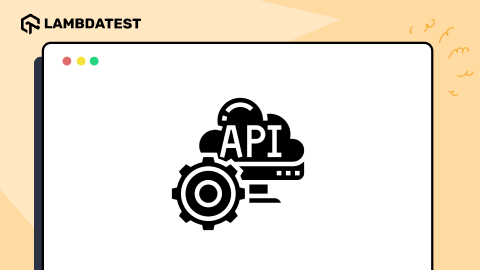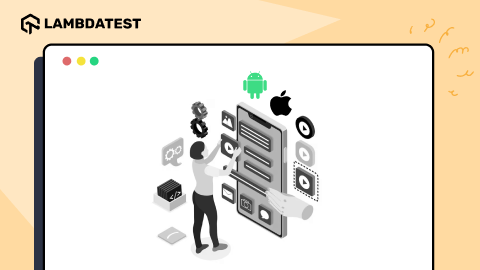How To Test Mobile Applications Manually
Harish Rajora
Posted On: November 24, 2021
![]() 29595 Views
29595 Views
![]() 16 Min Read
16 Min Read
This article is a part of our Content Hub. For more in-depth resources, check out our content hub on Mobile App Testing Tutorial.
Mobile phones add a lot of convenience to our daily life. For example, if you are planning a vacation and want to check out the best resorts available in that area or want to check the cost and availability of tickets, then the first thing you will look for in such cases is the mobile phone and the related applications. Mobile applications are at the core of many businesses, and it is important to have a good quality application. Mobile application manual testing is a great way to identify UI issues and ensure a bug-free application.
Mobile phones have three major advantages that have proved their importance to the world – they are easy to operate, high in power, and are so small that sometimes people keep more than one with them. That’s a perfect combination for something not only to sustain but to flourish at a rate that nobody can imagine.
The growth rate of mobile devices has been exceptional as a product all over the globe.
When a product grows at such a rate, people want to take advantage of it. Hence, the number of Android and iOS developers increased to a record 8.7 million out of 19 million software developers.
In this blog on mobile app testing, we will see why testing any mobile application is a crucial activity and how to test mobile apps manually using cloud-based tools like LambdaTest.
TABLE OF CONTENTS
Mobile applications manual testing – Is it viable?
Before proceeding with the core part on how to test mobile applications manually, it is essential to know if the mobile application manual testing is worthy of our time?
Mobile applications have become quite complex in development and their working. Due to this, the following cases still stand firm on the side of mobile application manual testing.
Better judgement of UI
Mobile application manual testing is performed by a tester manually. Even though automation tools and frameworks have evolved greatly in the UI department (like locating the element accurately and defining its position on the screen), they still cannot be 100% accurate. On the other hand, through mobile application manual testing, we can observe the UI’s slightest nuances and notify the development team.
A good use case around mobile application manual testing is while using an iframe type of container in the app, and you might have the image inside it but not by exact proportion (there are chances that it could get cut in one of the sides). Such issues cannot be tested through automation, and one has to rely on mobile application manual testing.
Mimic real user
Mimicking a real user is the toughest and the most important thing in mobile application manual testing. Everything depends on the end-user when it comes to popularity, the business, and even the application’s working. If you don’t perform mobile app testing in a similar way as the end-user would operate it, you will never be able to perfect it for your audience.
So who is the best for mimicking a real end-user – a real user. Mobile application manual testing takes the upper hand when operating the mobile application like a user and not a robot. Of course, you can also go with automation, but the number of permutations is extremely high. But, with mobile application manual testing, it can be done very quickly. Therefore, in such a case, mobile application manual testing saves time when compared to automation.
Complex use cases can be simplified
Many mobile app testing use cases are complex to be scripted in the form of automation test cases. For example, gaming brings out the most challenging use cases when it comes to mobile app testing.
Also read – Challenges in mobile app testing
The combination of multiple actions such as swiping, moving forward, backward, tapping, or swiping in a different order (like circular) is hard to predict from the user’s point of view. Only if we can do these actions ourselves through mobile application manual testing will we notice hidden bugs.
Not only in the situations mentioned above, but even otherwise, we can name scenarios where mobile application manual testing becomes necessary and is the only viable way forward. Also, we should never consider going for 100% automated mobile app testing in the above scenarios as it is a waste of time. For example, UI can be efficiently tested using automation. But we may need the mobile application manual testing for corner cases. So a mix of both is probably the best when it comes to mobile app testing.
Also read: Automating Acceptance Tests For Mobile Apps
Now that you understand the importance of mobile application manual testing, the next question that would come to your mind is “how to test mobile applications manually?”. In the next section, we are going to explain in detail how to test mobile applications manually.
How to test mobile applications manually?
Let’s now see how to perform mobile application manual testing using the below options.
Emulators and Simulators
The oldest way of doing mobile application manual testing has been the use of emulators and simulators. They are so popular you might also get them built into the framework you are using for development, such as Android studio. Emulators and simulators let you select the mobile device model and run it on your computer screen. They mimic the device and give you a gist of how the app will behave when used on real devices after launch.
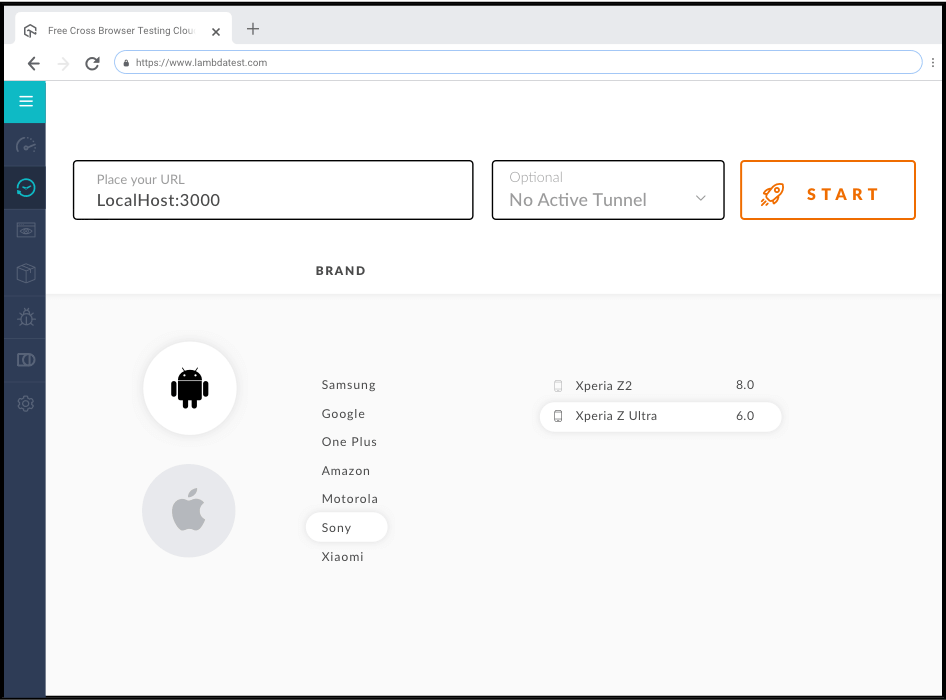
Some of the testers are often confused about the difference between emulators and simulators. Although they differ in many scenarios, their major difference comes while considering the hardware of the OS and device while running the application. Emulators run an application accounting for the hardware specifications while simulators do not. If you would like to learn more, read the blog about the differences and similarities between emulators and simulators.
Also read: Getting Started With Mobile App Testing Using Emulators And Simulators
Emulators and simulators are cost-efficient options you would get for mobile application manual testing. They come in both free and paid options. Here’s your free opportunity for mobile emulator app testing.
Real device cloud
Real device cloud is a mobile app testing environment that contains a huge collection of real mobile devices that you can use to test using the cloud. Using a real device cloud, you can perform mobile application manual testing and identify bugs related to battery usage, connectivity, etc.
How to perform mobile application manual testing using LambdaTest?
In 2021, the cross browser testing platform LambdaTest joined the club of companies providing emulators and simulators for mobile application manual testing. The mobile app testing module comes integrated into the platform and is free to use for a limited time. It has numerous advantages over other free emulators and simulators, which I have listed down below for your reference.
Here’s a short glimpse of LambdaTest mobile app testing features:
Also Read: Mobile App Testing is Now LIVE On LambdaTest!
Cloud-based
Android studio consumes huge memory that slows down the system. If you have a lower primary memory like 4GB or 6GB, it becomes difficult or impossible to perform mobile app testing on different emulators and simulators faster. Popular forums such as Quora and StackOverflow are filled with questions asking for a turnaround in memory consumption. Google has also updated its documentation describing efficient ways to manage memory on app.
LambdaTest eliminates this concept and enables cloud-based mobile app testing using emulators and simulators. Since LambdaTest mobile app testing is cloud-based, you just need a system with a browser and a stable internet connection. The powerful infrastructure of LambdaTest takes care of it all at their end.
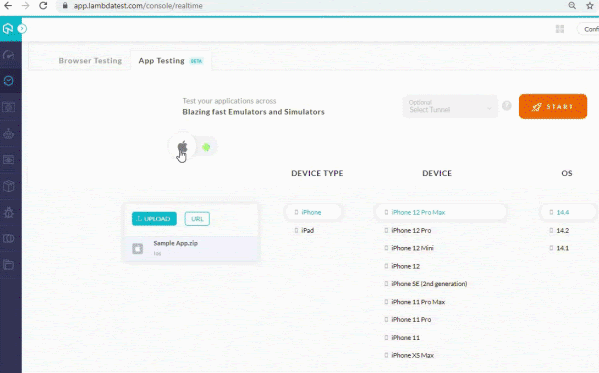
Another important point to note is what would happen if we use a native emulator like Android Studio and our PC gets affected by a virus and crashes down? This brings us to the risk of losing all the data and starting all over again. However, the cloud-based platform can be accessed from anywhere, and all your data is kept on the cloud, safe, and the UI’s slightest nuances are used from any location and any PC.
Learning Curve
The next issue people face while dealing with benchmark emulators and simulators such as Android studio is the constant change over the years. From MK files to NK to shared libraries, it feels like testers get a new software with the same name each year and start learning all over again.
LambdaTest has a very shallow learning curve. A few simple steps of “upload,” “launch,” “start” (as demonstrated in the later section), and you are done with mobile application manual testing easily.
Easy geo-location
The next difference that gives LambdaTest an edge over Android studio-type emulators is the ease of geo-location testing. Many emulators and simulators do not provide geo-location testing as a part of their executable package. But you can use third-party software and set the location as per your choice. For example, in Android studio, you have to use telnet for geo-location testing. With geo fix <longitude value> <latitude value>, you can fix the latitude and longitude of the location you want your app to open in. Although we all know how third-party support goes in the future.
LambdaTest can save you from all this trouble by providing the geo-location services embedded into their platform to perform mobile application manual testing. In addition, the tester gets a dropdown option while running the emulator on which they can select the country they wish to open their app in.
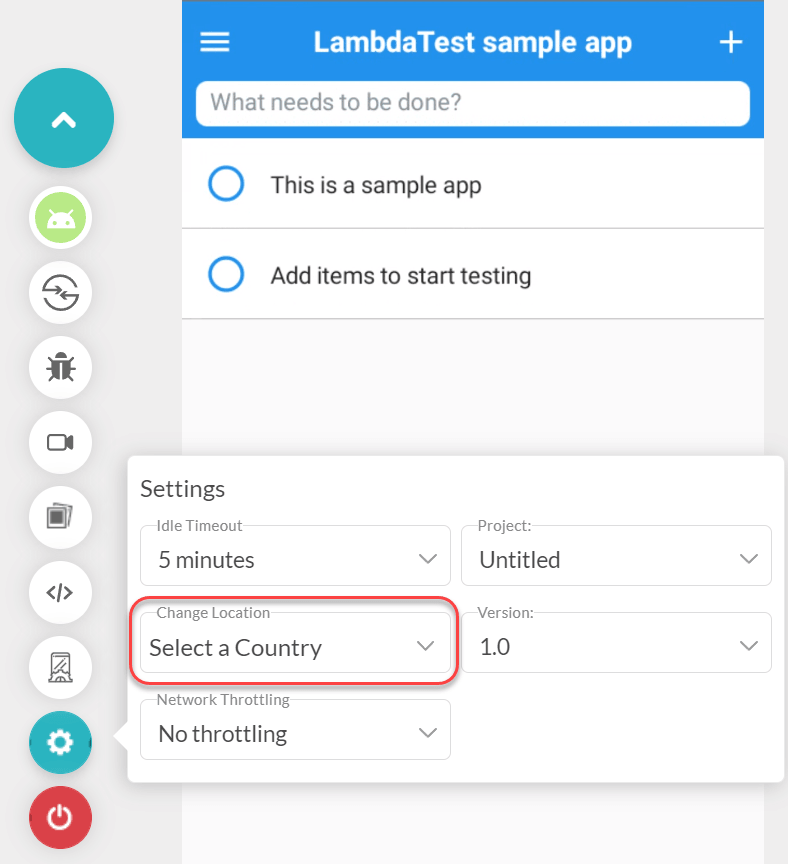
With this, they can view their app and verify if it is geo-blocked or working correctly in different locations in minutes.
Localization testing
LambdaTest’s mobile app testing module can be used for localization testing to ensure that the elements in your application changes according to the region or not. These may include regional languages, local time, displaying regional currency, etc.
Android and iOS support
The emulators and simulators provided by the OS developers generally bring the first updates to the most current changes on the OS. So, for example, if Google is thinking about releasing a new API for Android, it will be visible in the Android Studio first (similar to how Google’s new OS is always available to the Pixel first). However, they fail at one simple point – serving apps developed to run on other OS.
Looking to perform Android and iOS app testing on Real Device Cloud, check out our video below –
No OS would want to promote other competitors, and therefore they stick to their own platform’s application. Nevertheless, many tools have emerged, providing Android and iOS support to the tester at a single location. LambdaTest’s collection of emulators and simulators contains Android and iOS supported devices that provide all the functionalities, including real-time logs for detailed debugging. The clearer a bug is seen, the better the end quality of the application.
Apart from all this, LambdaTest gives you support 24×7 when you get stuck (which happens a lot), an extensive document to perform real-time mobile app testing, and many third-party integrations to make your work easier. Here I would like to mention two things based on our discussion to this point. First, it is not that these things are not available for other tools, but you may not find all of the things in a single place. For example, open-source software often troubles us with integrations because there is no specific build for both of them. Sometimes you may have to use two different tools altogether (like integrations) to leverage their power. But these will not be connected, and so the process becomes slow.
Secondly, I have used Android studio many times in this post to reference how LambdaTest’s mobile application manual testing module can prove fruitful to you as a tester. This does not mean the points imply only to the Android studio. Most open-source emulators and simulators face similar issues and can even be more on the off-side in providing additional functionality. Having everything on a single dashboard gives flexibility and saves a lot of time in testing.
So, now we are covered up with emulators and simulators and are ready to demonstrate mobile application manual testing through LambdaTest.
To perform mobile application manual testing, login to LambdaTest and move to real-time testing from the side-panel.

Here, you get an option to perform mobile app testing. Select “App Testing” on the screen:

Select the OS your app is built for and upload the executable file here.
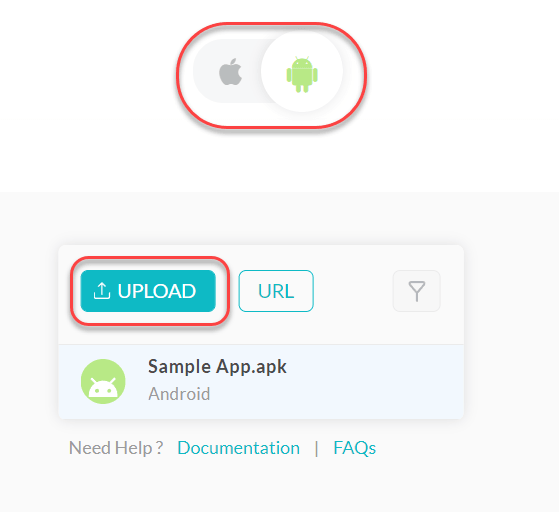
For users who are exploring the platform, a sample app to test is provided. If you intend to run that sample app like me, just move ahead to the next step without pressing UPLOAD.
Next, choose the device from the list on the right on which you want your application to run. You will get devices according to the chosen OS. Since I opted for Android here, I will get devices available with Android OS in the market.

We are all set now to press start and launch an emulator of the device we selected.
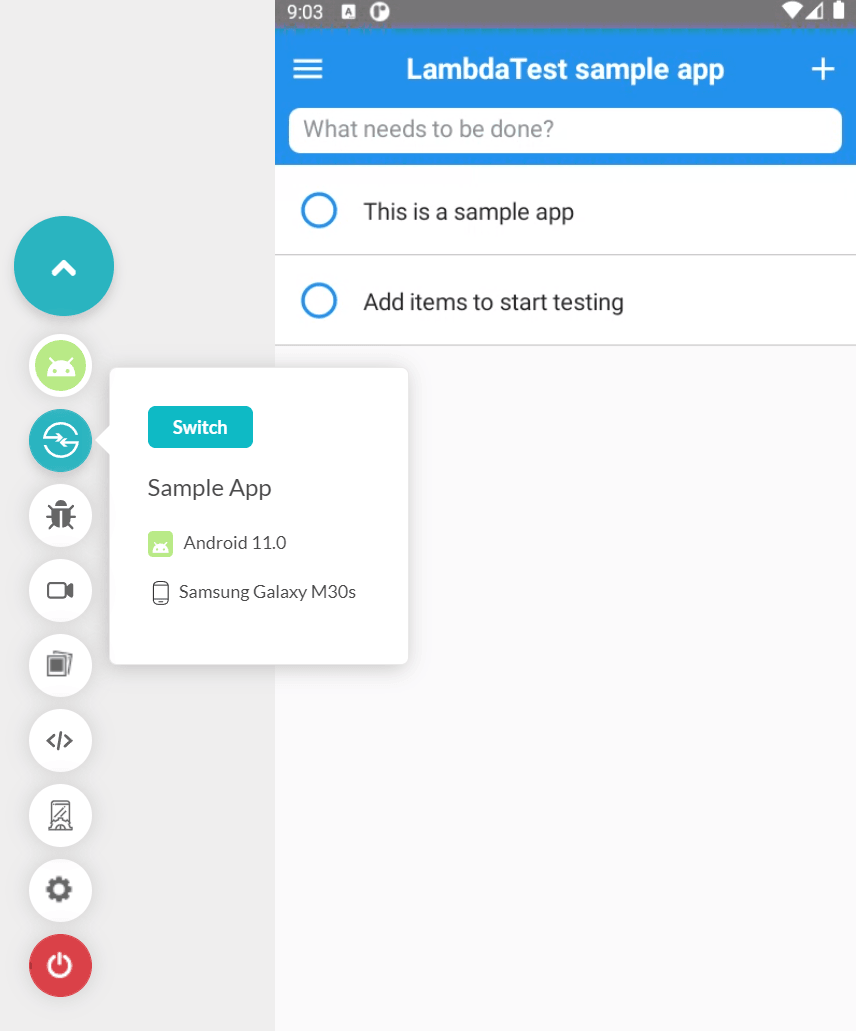
If you have performed cross-browser testing on LambdaTest, the interface of the mobile app testing will look a lot familiar to you. This can also help speed things up. But if this is your first time, you will see a panel on the left side that will contain the tools to enhance your mobile testing experience.
You can also switch your OS from within this panel directly, mark bugs with different shapes and texts, change location and even debug from this screen.
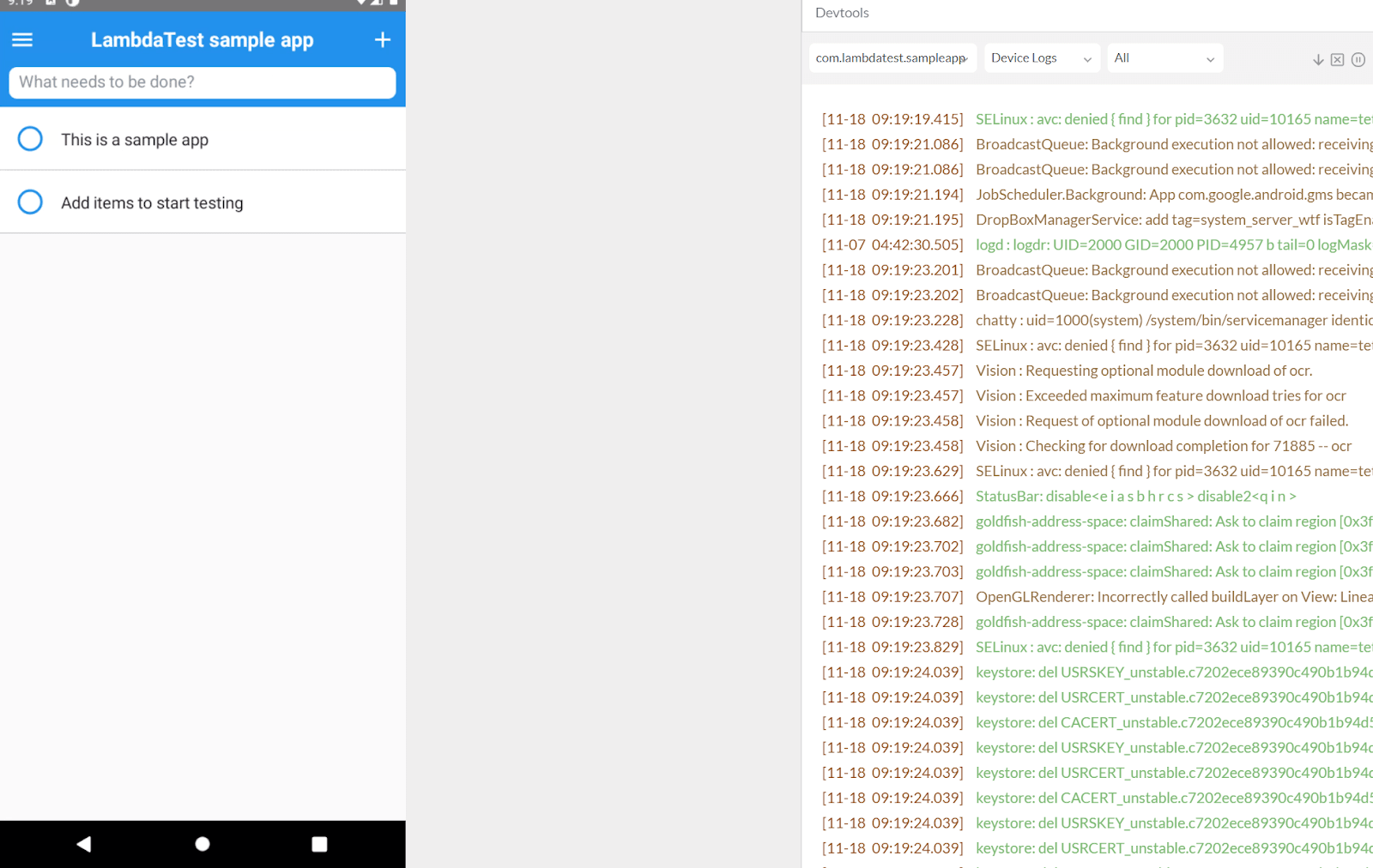
LambdaTest mobile testing with logs for efficient debugging
This tool is free to explore, and you can try with different apks or apple executables and let us know your experience in the comment section.
Also read: The Ultimate Mobile App Testing Checklist
You can also refer to the below video tutorial on how to perform real-time browser testing on LambdaTest.
Summary
Let’s iterate over our post from the top to conclude what we discussed all through. Mobile devices have become an important part of both a user and a business. Since a user spends more than 200 minutes on average operating their mobile device, what could be the best option for a business to expand and be noticeable all the time. But since everybody knows that, everybody develops that.
Today, it is quite rare to not have an application on the application hosting platforms. Such a high competition does not leave any scope for mistakes, and therefore a higher responsibility on testers falls in. Now a tester has two jobs, devising a mobile app testing strategy and choosing a perfect method of performing mobile application manual testing.
Emulators and simulators have a lot of options, and a majority of them have to be installed on a personal system that takes a lot of resources. Moreover, if your system crashes, you are at risk of losing all your testing data. So the best bet is to go for cloud-based emulators and simulators service to perform mobile application manual testing that can give you all the features at a single location so that you can give all your time to testing. In this post, we introduced LambdaTest is a cloud-based mobile app testing platform. If you have never tried any of those before, you can sign up for a free trial.
Also, read our short guide on what is a mobile application?
Frequently Asked Questions
How to Test Mobile Applications Manually?
You can perform mobile application manual testing using emulators or simulators and by choosing the desired device. You can also perform mobile application manual testing using real device cloud or setting up a device lab within your organization.
What is a real device cloud?
Real device cloud is a mobile testing environment that contains a huge collection of real mobile devices that you can use to test using the cloud. Using a real device cloud, you can perform mobile application manual testing and identify bugs related to battery usage, connectivity, etc.
Why is mobile app testing important?
The growth rate of mobile devices has been exceptional as a product all over the globe. It has opened a new market for people in terms of career and business. Today you may or may not find a website for a business, but you will find a mobile application for it. So mobile apps are extremely important to stay ahead of your competitors. But for that, you need a good quality mobile application, which can only be achieved through rigorous mobile app testing.
What are the types of mobile applications?
There are three types of mobile applications – Native, hybrid, and web application. Read this blog to understand the difference between Native, hybrid, and web applications in detail.
Got Questions? Drop them on LambdaTest Community. Visit now













